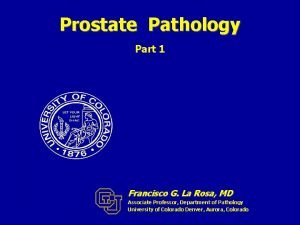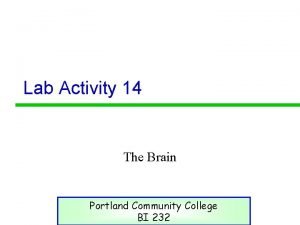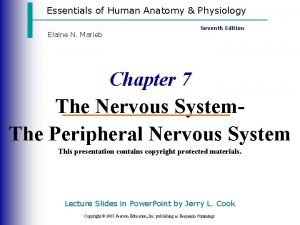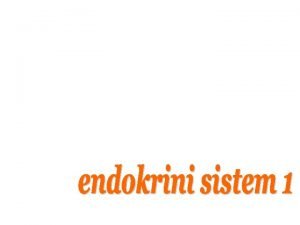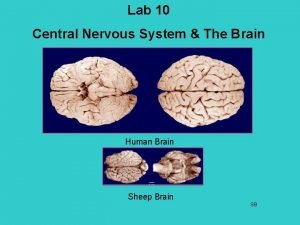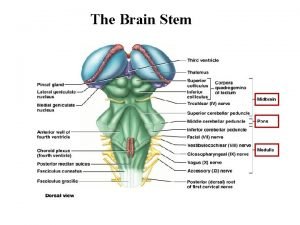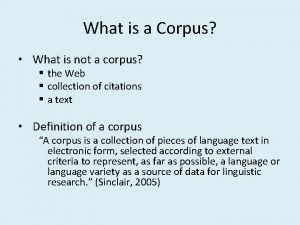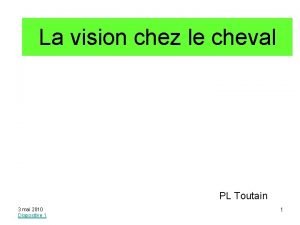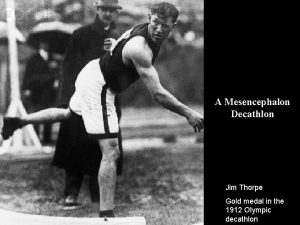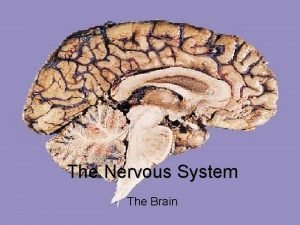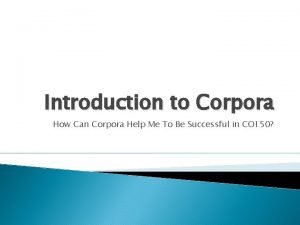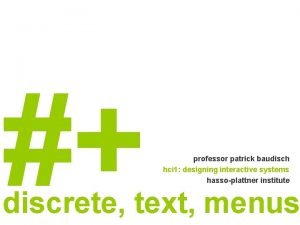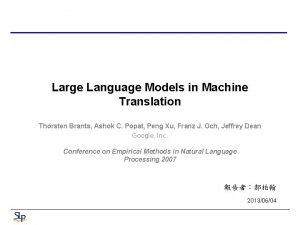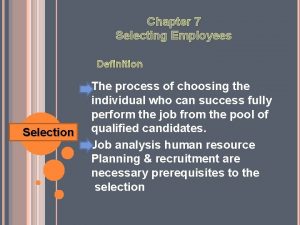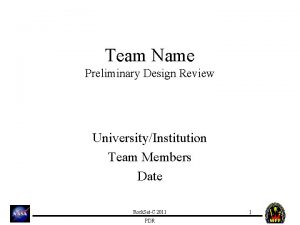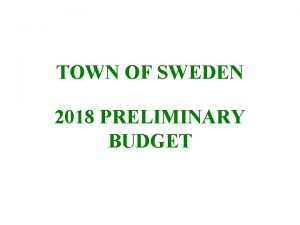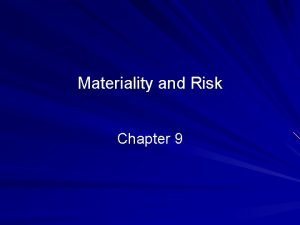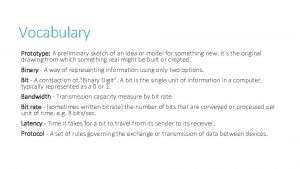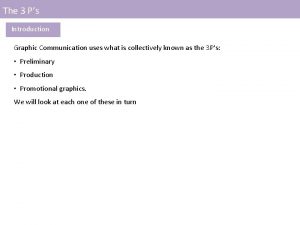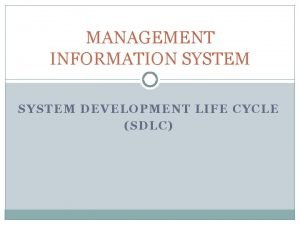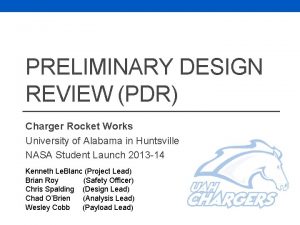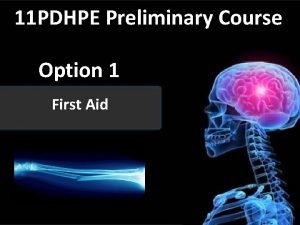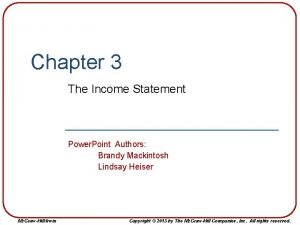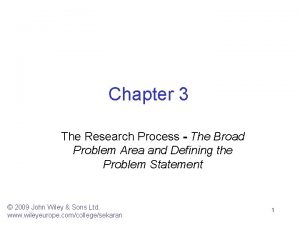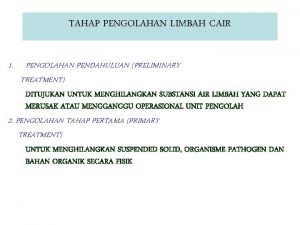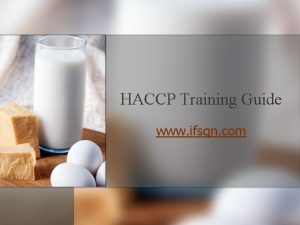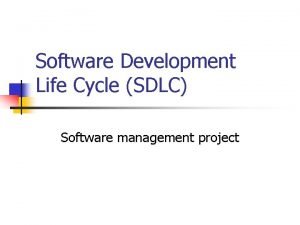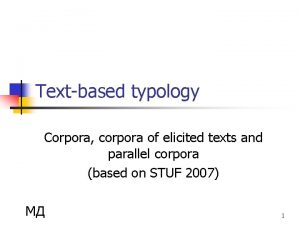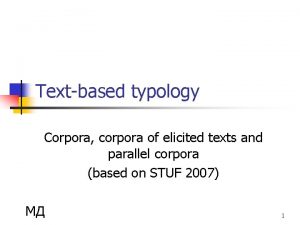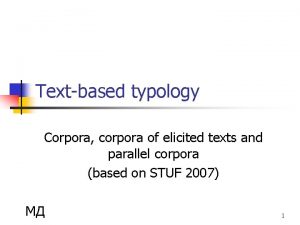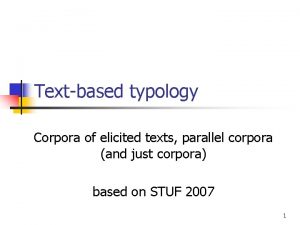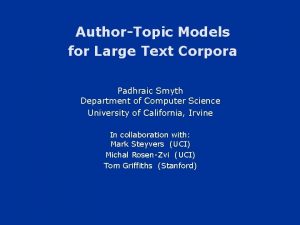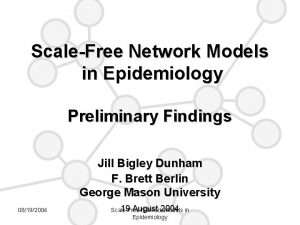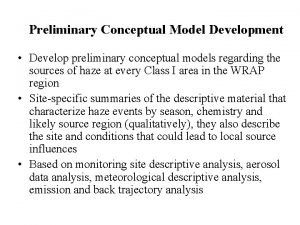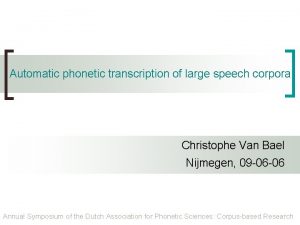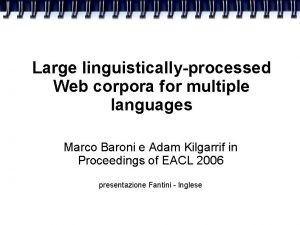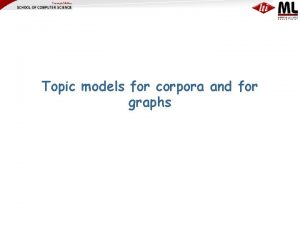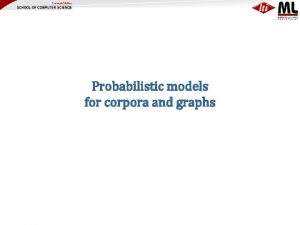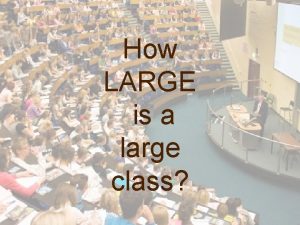Large Models for Large Corpora preliminary findings Patrick



























![VTLN: Linear equivalence • According to [Pitz, ICSLP 2000], VTLN is equivalent to a VTLN: Linear equivalence • According to [Pitz, ICSLP 2000], VTLN is equivalent to a](https://slidetodoc.com/presentation_image/0d2dd53f72f291b6396793fba3570424/image-28.jpg)








- Slides: 36

Large Models for Large Corpora: preliminary findings Patrick Nguyen Ambroise Mutel Jean-Claude Junqua Panasonic Speech Technology Laboratory (PSTL)

… from RT-03 S workshop • Lots of data helps • Standard training can be done in reasonable time with current resources • 10 kh: it’s coming soon • Promises: – Change the paradigm – Use data more efficiently – Keep it simple

The Dawn of a New Era? • Merely increasing the model size is insufficient • HMMs will live on • Layering above HMM classifiers will do • Change topology of training • Large models with no impact on decoding • Data-greedy algorithms • Only meaningful with large amounts

Two approaches: changing topology • Greedy models – Syllable units – Same model size, but consume more info – Increase data / parameter ratio – Add linguistic info • Factorize training: increase model size – Bubble splitting (generalized SAT) – Almost no penalty in decoding – Split according to acoustics

Syllable units • • Supra-segmental info Pronunciation modeling (subword units) Literature blames lack of data TDT+ coverage is limited by construction (all words are in the decoding lexicon) • Better alternative to n-phones

What syllables? • NIST / Bill Fisher tsyl software (ignore ambi-syllabic phenomena) • “Planned speech” mode • Always a schwa in the lexicon (e. g. little) • Phones del/sub/ins + supra-seg info is good onset rhyme peak coda (Body, Tail)

Syllable units: facts • Hybrid (syl + phones) – [Ganapathiraju, Goel, Picone, Corrada, Doddington, Kirchhoff, Ordowski, Wheatley; 1997] • Seeding with CD-phones works – [Sethy, Narayanan; 2003] • • State tying works [PSTL] Position-dependent syllables work [PSTL] CD-syllables kind of works [PSTL] ROVER should work – [Wu, Kingsbury, Morgan, Greenberg; 1998] • Full embedded re-estimation does not work [PSTL]

Coverage and large corpus • Warning: biased by construction • In the lexicon: 15 k syllables 127 examples 1 example 14 examples • About 15 M syllables total (10 M words) • Total: 1600 h / 950 h filtered

Coverage CI-Syl Pos-CI Syl Pos-CD Syl 10 k 99. 7% 99. 5% 94. 7% 6 k 99. 7% 98. 5% 90. 7% 3 k 98. 2% 95. 0% 82. 2% 2 k 95. 9% 91. 1% 76. 0% 1. 5 k 93. 4% 87. 6% 71. 3% 1 k 88. 7% 81. 6% 64. 6%

Hybrid: backing off • Cannot train all syllables => back-off to phone sequence • “Context breaks”: context-dependency chain will break • Two kinds of back-off: abduction – True sequence: ae_b d_ah_k sh______ih______n – [Sethy+]: ae_b d_ah_k sh+ih sh-ih+n ih-n – [Doddington+]: ae_b d_ah_k k-sh+ih sh-ih+n ih-n • Tricky • We don’t care: state-tying and almost never backoff

Seeding • Copy CD models instead of flat-starting • Problem at syllable boundary (context break) • CI < Seed syl < CD • Imposes constraints on topology ? ? -sh+ih sh-ih+n ih-n+? ?

Seeding (results) • Mono-Gaussian models • Trend continues even with iterative split • • CI: CD: Syl-flat: Syl-seed: 69% WER 26% WER 41% WER 31% WER (CD init)

State-tying • Data-driven approach • Backing-off is a problem => train all syllables – too many states/distributions – too little data (skewed distribution) • Same strategy as CD-phone: entropy merge • Can add info (pos, CD) w/o worrying about explosion in # of states

State-tying (2) • Compression w/o performance loss • Phone-internal, state-internal bottom-up merge to limit computations • Count about 10 states per syllable (3. 3 phones) • • Pos-dep CI syllables 6000 syl model: 59 k Gaussians: 38. 7% WER Merged to 6 k: (6 k Gaussians): 38. 6% WER Trend continues with iterative split

Position-dependent syllables • Word-boundary info (cf triphones) • Example: – Worthiness: _w_er dh_iy n_ih_s – The: _dh_iy_ • Missing from [Sethy+] and [Dod. +] • Results: (3% absolute at every split) – Pos-indep (6 k syl): 39. 2% WER (2 dps) – Pos-dep: 35. 7% WER (2 dps)

CD-Syllables • • • Inter-syllable context breaks Context = next phone Next syl? Next vowel? (Nucleus/peak) CD(phone)-syl >= CD triphones Small gains! • • All GD results CI-syl (6 k syl): 19. 0% WER CD-syl (20 k syl): 18. 5% WER CD-phones: 18. 9% WER

Segmentation • Word and Subword units give poor segmentation • Speaker-adapted overgrown CD-phones are always better • Problem for: MMI and adaptation • Results: (ML) – Word-internal: 21. 8% WER – Syl-internal: 19. 9% WER

MMI/ADP didn’t work well • MMI: time-constrained to +/- 3 ms within word boundary • Blame it on the segmentation (Word-int) CD-phones CD-syl ML MMI +adp 18. 9% 17. 5% 15. 5% -1. 4% -2% 17. 4% 16. 0% -1. 1% -1. 4% 18. 5%

ROVER • Two different systems can be combined • Two-pass “transatlantic” ROVER architecture • CD-phones align, phonetic classes • No gain (broken confidence), deletions – MMI+adp: 15. 5% (CDp) and 16. 0% (SY) – Best ROVER: 15. 5% WER (4 -pass, 2 -way) Syllable models Adapted CD-phones

Summary: architecture CD-phones POS-CI syllables Merged (6 k) POS-CD syllables GD / MMI Decode Adapt+decode ROVER Merged (3 k)

Conclusion (Syllable) • Observed similar effects as literature • Added some observations (state tying, CD, pos, ADP/MMI) • Performance does not beat CD-phones yet – CD phones: 15. 5% WER ; syl: 16. 0% WER • Some assumptions might cancel the benefit of syllable modeling

Open questions • Is syllabification (grouping) better than random? Syllable? • Planned vs spontaneous speech? • Did we oversimplify? • Why do subword units resist to autosegmentation? • Why didn’t CD-syl work better? • Language-dependent effects

Bubble Splitting • Outgrowth of SAT • Increase model-size 15 -fold w/o computational penalty in train/decode • Also covers VTLN implementation • Basic idea: – Split training into locally homogenous regions (bubbles), and then apply SAT

SAT vs Bubble Splitting • SAT relies on locally linearly compactable variabilities • Each Bubble has local variability • Simple acoustic factorization SAT Adaptation (MLLR) Bubble

TDT and speakers labels • TDT is not speaker-labeled • Hub 4 has 2400 nominative speakers • Use decoding clustering (show-internal clusters) • Males: 33 k speakers • Females: 18 k speakers • Shows: 2137 (TDT) + 288 (Hub 4)

Bubble-Splitting: Overview Input Speech M A L SPLIT ADAPT NO Maximum Likelihood RM E ALI ZE Multiplex TDT F E M A R SPLIT L E Compact Bubble Models (CBM) ADAPT NO E LIZ MA Decoded Words

VTLN implementation • VTLN is used for clustering • VTLN is a linear feature transformation (almost) • Finding the best warp
![VTLN Linear equivalence According to Pitz ICSLP 2000 VTLN is equivalent to a VTLN: Linear equivalence • According to [Pitz, ICSLP 2000], VTLN is equivalent to a](https://slidetodoc.com/presentation_image/0d2dd53f72f291b6396793fba3570424/image-28.jpg)
VTLN: Linear equivalence • According to [Pitz, ICSLP 2000], VTLN is equivalent to a linear transformation in the cepstral domain: • The relationship between a cepstral coefficient ck and a warped one (stretched or compressed) is as follows: • The Authors didn’t take the Mel-scale into account. No closed-form solution in that case : • Energy, Filter-banks, and cepstral liftering imply non-linear effects

VTLN is linear Decoding Algorithm: INPUT Decode with SPEECH DECODED Ai and λ WORDS Experimental results:

Statistical multiplex • GD-mode • Faster than Brent search • 3 times faster than exhaustive search • Based on prior distribution of alpha • Test 0. 98, 1, and 1. 02 • If 0. 98 wins, continue 1. 00 3 Q evaluations: N 1. 00=3 0. 98 4 Q evaluations: N 0. 98 = N 1. 02 = 4

Bubble Splitting: Principle Partial center: satmodel λi Training Speaker Bubble Bi 1. Separate conditions • VTLN 2. Train Bubble model 3. Compact using SAT • Feature-space SAT works on homogenous conditions

Results 1 st-pass adapted Baseline GD 19. 0% 16. 6% SAT 18. 7% 16. 5% Bubbles 18. 5% 16. 0% 192 k => 384 k 18. 6% 16. 3% About 0. 5% WER reduction Double model size => 0. 3% WER

Conclusion (Bubble) • Gain: 0. 5% WER • Extension of SAT model compaction • VTLN implementation more efficient

Open questions • • • Baseline SAT does not work? Speaker definition? Best splitting strategy? (One per warp) Best decoding strategy? (Closest warp) Best bubble training? (MAP/MLLR) MMIE

Conclusion • What do we do with all of these data? • Syllable + bubble splitting • Two narrowly explored paths among many • Promising results but nothing breathtaking • Not ambitious enough?

System setup • RT 03 eval • 6 x RT • Same parameters as RT 03 S eval system – WI triphones, gender dependent, MMI – 2 pass – Global MLLU + 7 -class MLLR – 39 MFCC + non-causal CMS (2 s) – 192 k Gaussians, 3400 mixtures – 128 Gaussians / mix => merged
 Representativeness in corpus design
Representativeness in corpus design Nodular hyperplasia
Nodular hyperplasia Corpora quadrigemina
Corpora quadrigemina Cranial nerves mnemonic
Cranial nerves mnemonic What is corpus
What is corpus Optička hijazma
Optička hijazma Intermediate mass
Intermediate mass Brainstem dorsal view
Brainstem dorsal view Corpora
Corpora Corpora nigra cheval
Corpora nigra cheval Corpora quadrigemina pronunciation
Corpora quadrigemina pronunciation Hind brain
Hind brain Corpora
Corpora Patrick is designing a large
Patrick is designing a large Modal and semi modal verbs
Modal and semi modal verbs Thorsten brants
Thorsten brants Preliminary outline speech
Preliminary outline speech Preliminary interview
Preliminary interview Preliminary design review template
Preliminary design review template Preliminary budget
Preliminary budget Preliminary materiality
Preliminary materiality Process of advertising research
Process of advertising research Preliminary prototype
Preliminary prototype The 3 p's graphic communication
The 3 p's graphic communication Primary marksmanship instruction
Primary marksmanship instruction The most creative and challenging phase of sdlc is
The most creative and challenging phase of sdlc is Preliminary design review example
Preliminary design review example Reading part 6 pet 2020
Reading part 6 pet 2020 First aid situational analysis
First aid situational analysis Shower approach in international marketing
Shower approach in international marketing Determine junktrader’s preliminary net income.
Determine junktrader’s preliminary net income. Broad problem area example
Broad problem area example Preliminary treatment adalah
Preliminary treatment adalah External sources of recruitment
External sources of recruitment Preliminary steps of haccp
Preliminary steps of haccp The preliminary audit strategy
The preliminary audit strategy Goto/sdle
Goto/sdle

